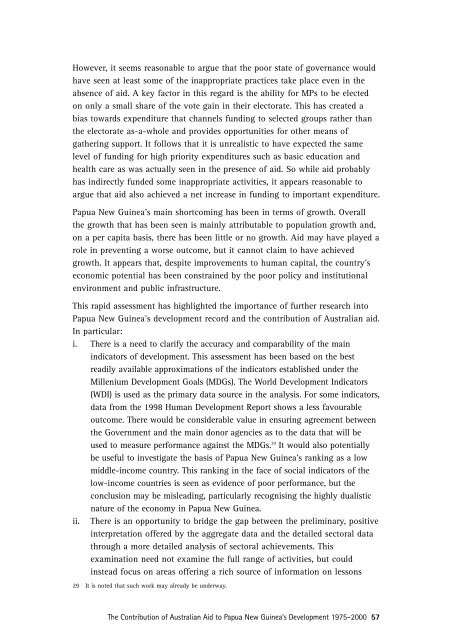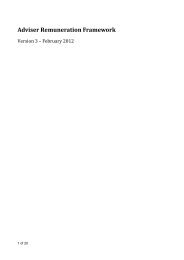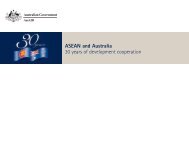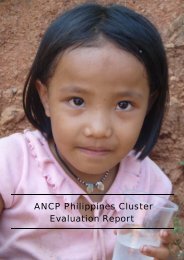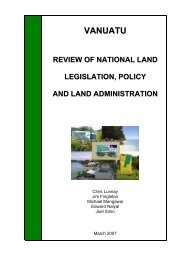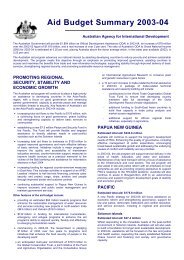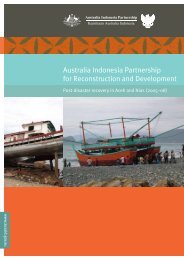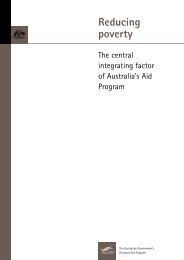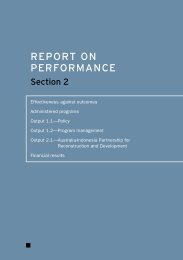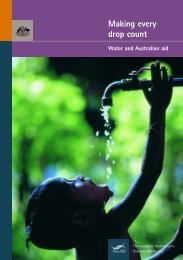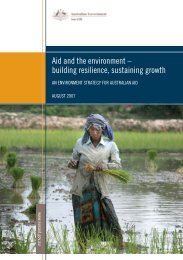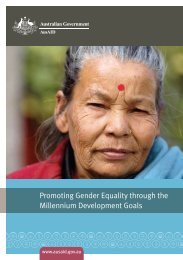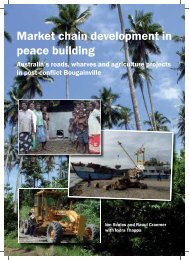Australian Aid to PNG - AusAID
Australian Aid to PNG - AusAID
Australian Aid to PNG - AusAID
You also want an ePaper? Increase the reach of your titles
YUMPU automatically turns print PDFs into web optimized ePapers that Google loves.
However, it seems reasonable <strong>to</strong> argue that the poor state of governance wouldhave seen at least some of the inappropriate practices take place even in theabsence of aid. A key fac<strong>to</strong>r in this regard is the ability for MPs <strong>to</strong> be electedon only a small share of the vote gain in their elec<strong>to</strong>rate. This has created abias <strong>to</strong>wards expenditure that channels funding <strong>to</strong> selected groups rather thanthe elec<strong>to</strong>rate as-a-whole and provides opportunities for other means ofgathering support. It follows that it is unrealistic <strong>to</strong> have expected the samelevel of funding for high priority expenditures such as basic education andhealth care as was actually seen in the presence of aid. So while aid probablyhas indirectly funded some inappropriate activities, it appears reasonable <strong>to</strong>argue that aid also achieved a net increase in funding <strong>to</strong> important expenditure.Papua New Guinea’s main shortcoming has been in terms of growth. Overallthe growth that has been seen is mainly attributable <strong>to</strong> population growth and,on a per capita basis, there has been little or no growth. <strong>Aid</strong> may have played arole in preventing a worse outcome, but it cannot claim <strong>to</strong> have achievedgrowth. It appears that, despite improvements <strong>to</strong> human capital, the country’seconomic potential has been constrained by the poor policy and institutionalenvironment and public infrastructure.This rapid assessment has highlighted the importance of further research in<strong>to</strong>Papua New Guinea’s development record and the contribution of <strong>Australian</strong> aid.In particular:i. There is a need <strong>to</strong> clarify the accuracy and comparability of the mainindica<strong>to</strong>rs of development. This assessment has been based on the bestreadily available approximations of the indica<strong>to</strong>rs established under theMillenium Development Goals (MDGs). The World Development Indica<strong>to</strong>rs(WDI) is used as the primary data source in the analysis. For some indica<strong>to</strong>rs,data from the 1998 Human Development Report shows a less favourableoutcome. There would be considerable value in ensuring agreement betweenthe Government and the main donor agencies as <strong>to</strong> the data that will beused <strong>to</strong> measure performance against the MDGs. 29 It would also potentiallybe useful <strong>to</strong> investigate the basis of Papua New Guinea’s ranking as a lowmiddle-income country. This ranking in the face of social indica<strong>to</strong>rs of thelow-income countries is seen as evidence of poor performance, but theconclusion may be misleading, particularly recognising the highly dualisticnature of the economy in Papua New Guinea.ii. There is an opportunity <strong>to</strong> bridge the gap between the preliminary, positiveinterpretation offered by the aggregate data and the detailed sec<strong>to</strong>ral datathrough a more detailed analysis of sec<strong>to</strong>ral achievements. Thisexamination need not examine the full range of activities, but couldinstead focus on areas offering a rich source of information on lessons29 It is noted that such work may already be underway.The Contribution of <strong>Australian</strong> <strong>Aid</strong> <strong>to</strong> Papua New Guinea’s Development 1975–2000 57


